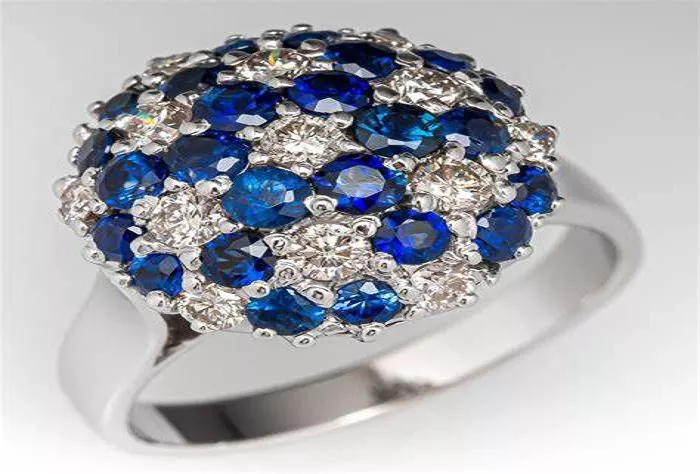A blue sapphire dome ring is a stunning piece of jewelry that combines elegance, durability, and timeless beauty. The dome-shaped design gives it a bold and luxurious look, while the deep blue sapphire adds a touch of sophistication.
This guide will cover everything you need to know about blue sapphire dome rings, including what makes them special, the best sapphire quality, popular designs and settings, how to choose the right ring, and care and maintenance tips.
Whether you’re buying one for yourself or as a gift, this article will help you make an informed decision.
What Is a Blue Sapphire Dome Ring?
A blue sapphire dome ring features a rounded, dome-shaped gemstone (usually a cabochon-cut sapphire) set in a ring. Unlike faceted gemstones, which have flat, polished surfaces, a cabochon sapphire has a smooth, polished dome with no cuts.
The key features of a blue sapphire dome ring include a dome-shaped sapphire with a smooth, rounded top for a sleek look, a rich blue color ranging from light blue to deep royal blue, durable material (sapphire is one of the hardest gemstones, ranking 9 on the Mohs scale), and versatile designs that can be set in gold, platinum, or silver.
This style is popular for engagement rings, statement rings, and vintage-inspired jewelry.
Why Choose a Blue Sapphire Dome Ring?
Timeless Beauty
Blue sapphires have been treasured for centuries. Their deep blue hue symbolizes wisdom, royalty, and elegance.
Durability
Sapphires are second only to diamonds in hardness, making them perfect for everyday wear.
Unique Look
The dome shape gives a vintage, mystical, or modern feel, depending on the setting.
Meaning & Symbolism
Sapphires represent loyalty, truth, and protection, making them meaningful for engagements and gifts.
Sapphire Quality: What to Look For
Not all sapphires are the same. When choosing a blue sapphire dome ring, consider the following factors:
Color
The best sapphires have a vivid, medium to dark blue tone. Avoid stones that are too light (washed out) or too dark (almost black).
Clarity
Cabochon sapphires often have slight inclusions (natural marks). A few inclusions are normal, but avoid stones with visible cracks.
Cut (Cabochon vs. Faceted)
Cabochon (dome) cut sapphires have a smooth, rounded surface with no facets, while faceted-cut sapphires have angled cuts for sparkle (though these are less common in dome rings).
Origin
Sapphires from Kashmir (India) are rare and highly prized for their velvety blue color. Burmese (Myanmar) sapphires are known for their deep, rich blue hue. Sri Lankan (Ceylon) sapphires offer a bright, medium blue, while Madagascar and Australian sapphires are more affordable options.
Popular Blue Sapphire Dome Ring Designs
Solitaire Dome Ring
A single blue sapphire cabochon in a simple setting creates a clean, elegant, and timeless look.
Halo Dome Ring
The sapphire is surrounded by small diamonds or gemstones, adding extra sparkle and luxury.
Vintage Dome Ring
Antique-inspired designs with intricate metalwork, often featuring engravings or milgrain details.
Three-Stone Dome Ring
The center sapphire is flanked by two smaller stones (diamonds or sapphires), symbolizing past, present, and future.
Men’s Dome Ring
A wider band with a bold sapphire cabochon, often in black or dark blue sapphire.
Best Metals for Blue Sapphire Dome Rings
The metal you choose affects the ring’s look, durability, and price.
Gold (Yellow, White, or Rose)
Yellow gold offers a classic, warm look. White gold provides a modern feel that enhances the blue sapphire. Rose gold gives a romantic and trendy appearance.
Platinum
Platinum is hypoallergenic, durable, and premium, making it ideal for heirloom-quality rings.
Silver
Silver is an affordable option but less durable than gold or platinum, making it suitable for fashion jewelry.
How to Choose the Right Blue Sapphire Dome Ring
Determine Your Budget
For 100−500, you can find lab-created sapphires in silver settings. Natural sapphires in gold settings typically range from 500−2,000. High-quality Kashmir or Burmese sapphires in platinum settings can cost $2,000 or more.
Pick the Right Size
Small sapphires (3-5mm) are delicate and great for everyday wear. Medium sapphires (6-8mm) offer a balanced look, ideal for engagement rings. Large sapphires (9mm+) make a bold statement.
Consider the Setting
A bezel setting is secure and modern. A prong setting is classic and allows more light to enter the stone. A channel setting is sleek and protects the stone.
Check for Certification
Always ask for a gemstone certificate (from GIA, AGL, or SSEF) to ensure the sapphire is natural and untreated (or to disclose any treatments).
Caring for Your Blue Sapphire Dome Ring
Cleaning Tips
Use warm soapy water and a soft brush to clean your ring. Avoid harsh chemicals like bleach or chlorine.
Storage
Store your ring in a separate jewelry box to prevent scratches.
Maintenance
Check the prongs or bezels every six months and schedule a professional cleaning once a year.
Conclusion
A blue sapphire dome ring is a timeless, elegant, and durable choice for any jewelry lover. Whether you prefer a simple solitaire or a vintage-inspired halo design, there’s a perfect ring for every style and budget.
By considering color, clarity, cut, and setting, you can find a high-quality sapphire ring that will last a lifetime.
Related Topics:
- What are Blue Star Sapphires Worth?
- What is a Blue Star Sapphire Worth?
- What is a Star Sapphire Ring?


